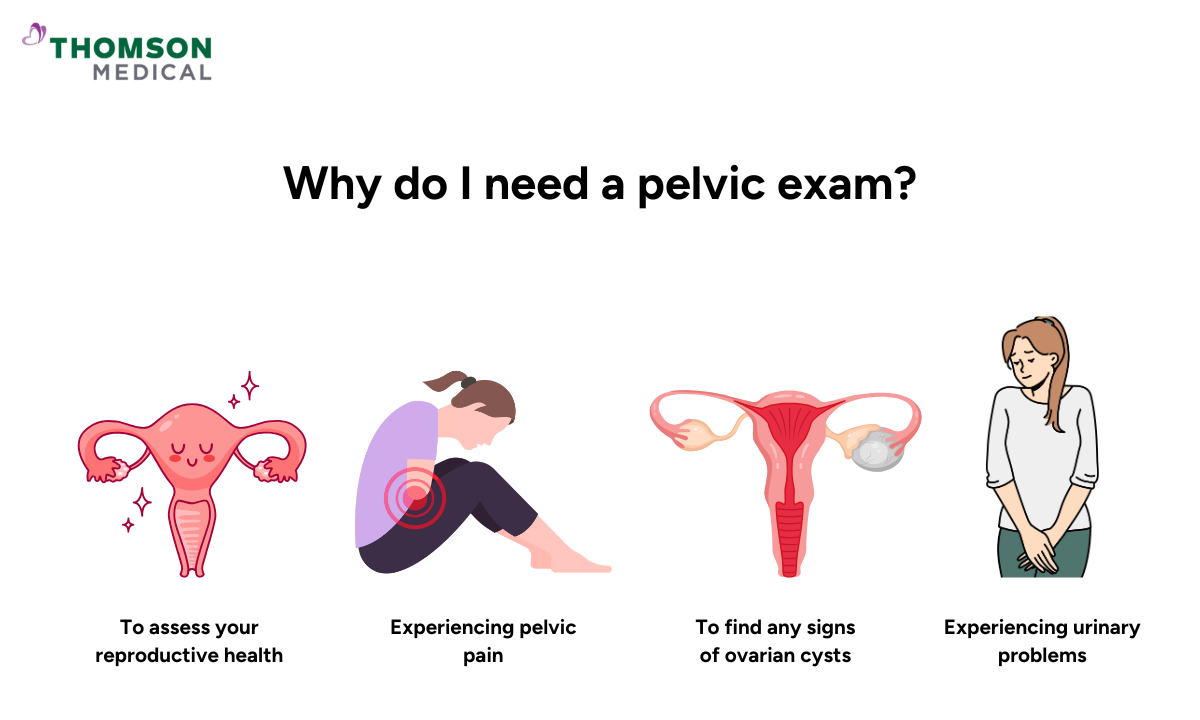What is a pelvic exam?
A pelvic exam is a physical evaluation that assesses the health of a woman's reproductive organs. It can help to detect potential health issues, such as infections and abnormal growths, at an early stage, when the likelihood of favourable treatment outcomes are higher.
In Singapore, these assessments are available at public and private hospitals, polyclinics, and GP clinics and are usually performed as part of a regular check-up. However, this does not mean that your doctor will always perform it during your visit.
During this physical exam, your doctor will also usually conduct a Pap smear and HPV test. This involves collecting a sample of cells from the lower part of the womb (the cervix) to assess your risk of cancer and screen for cervical cancer.
Why do I need a pelvic exam?

Your healthcare provider usually recommends a pelvic exam if you're experiencing, or have a medical history of, an abnormal condition affecting your reproductive organs. These include the uterus, ovaries, cervix, fallopian tubes, vagina, and vulva.
As these organs are important for your fertility and overall health, pelvic examinations are also commonly performed during the first prenatal visit during a pregnancy. Your doctor may recommend this physical examination for the following reasons:
- Assessing your general reproductive health
- To find any signs of ovarian cysts
- Checking for signs of uterine, cervical, or ovarian cancer
- To establish the cause of any vaginal bleeding
- Check for uterine infections or any irregularities in the size, shape or position of the uterus
- If you have a history of reproductive health conditions such as uterine fibroids or endometriosis
- If you have a history of human papillomavirus (HPV) or abnormal Pap test results
Additionally, this examination can also be performed if you show symptoms such as:
Pelvic pain
Pain during sex
Any urinary problems
It's recommended that you have your first pelvic exam by age 21 or earlier if you're sexually active. After your first exam, a regular screening is recommended as part of your preventive care. How often you need this test will depend on your age, health risks, and other factors.
Early detection can help prevent reproductive medical conditions from worsening. To find out if a pelvic examination is suitable for you, schedule an appointment with Thomson Medical. Our healthcare professionals can help determine whether this examination is right for you.
What do I need to prepare for a pelvic exam?
Before undergoing the pelvic exam, there is no special preparation you need to do. However, to make the exam more comfortable, you can:
- Schedule the examination for a time when you are not on your period
- Avoid sexual intercourse or using any vaginal products, such as creams or tampons, at least 24 hours before the test begins.
If it is your first time, don't hesitate to let your healthcare provider know. They can explain each step of the examination and answer any questions you may have.
What to expect during the pelvic examination
On the day of your appointment, your healthcare provider will start by asking you about your medical history, menstrual cycle, sexual activity and use of birth control. You may then be weighed and have your blood pressure checked.
Before the examination begins, you can use the toilet first to help you feel more comfortable. You may also be asked to provide a urine sample.
Before the pelvic examination begins, you will be asked to remove all your clothing, including your underwear, and change into a gown. Your healthcare provider may perform a few tests depending on your medical conditions, which include:
External examination:
During this test, your healthcare provider will examine your vagina and vulva (the external parts of the female genitals) for signs of infection, irritation, or abnormal discharge.
Speculum examination:
For this test, your healthcare provider will gently insert a speculum (a plastic or metal-hinged tool that is used to widen the vaginal walls) to examine your vagina and cervix for signs of infection or disease.
Pap smear test:
While the speculum is in place during the speculum examinations, your healthcare provider can also perform a Pap smear test. This test uses a thin wand or small brush to collect a sample of cells from your cervix. This sample is then tested for abnormalities that could indicate cervical cancer.
A sample may also be taken at this time to perform an HPV test, which checks for high-risk HPV strains that can increase the risk of cervical cancer.
Bimanual exam:
During this test, your healthcare provider will insert one or two lubricated, gloved fingers into your vagina while pressing on your abdomen. This allows them to look for lumps and assess the size, shape and position of your uterus and ovaries.
Rectovaginal exam (if necessary):
In some cases, your doctor may perform a rectovaginal exam, where one finger will be placed in the rectum and another in the vagina to check for deeper issues or abnormalities.
If any abnormalities (such as cysts, fibroids, or signs of infection) are detected during the examination, further tests may be recommended. These tests may include medical imaging assessment, such as a pelvic ultrasound, or laboratory tests, like blood tests or urine tests.

Pelvic exam cost in Singapore
In Singapore, pelvic examinations are available at public and private hospitals, polyclinics and general practitioners' (GP) clinics. The cost can vary depending on the facility, the included tests, and whether the examination is part of a women's health screening package.
Generally, comprehensive women's health screening packages, which include a pelvic examination, a Pap smear, a pelvic ultrasound and other tests, range in price from SGD 360 to SGD 570. However, depending on the package and provider, the cost may be higher, especially if additional blood or imaging tests are included.
Unfortunately, general health screenings, including pelvic examinations, are not covered by Medisave or the Community Health Assistance Scheme (CHAS), except for specific screenings under national programs. Some private health insurance providers may provide coverage, depending on the policy.
For detailed fee information and payment options, please consult your healthcare provider directly. Schedule an appointment with our specialists at Thomson Medical today for a detailed price breakdown and a personalised care plan.
Are there risks to pelvic exams?
Pelvic examinations are generally safe, so most people experience few or no side effects. However, it is possible to experience some mild symptoms after the examination. You may notice light vaginal bleeding, particularly if a Pap smear was performed, as well as slight cramping or discomfort. These symptoms usually resolve within a few hours.
Your doctor will keep tools sterile and maintain hygiene during the exam, so the risk of infection is low.
FAQ
Is a pelvic exam painful?
Although a pelvic examination may cause some discomfort, it should not be painful. For example:
- During a speculum exam, you may feel some pressure when the doctor gently inserts the speculum to widen the vaginal walls.
- You might also feel mild discomfort when a cell sample is taken for a Pap smear and HPV test.
- During a bimanual exam, your doctor will insert two fingers into your vagina while pressing on your abdomen to check your uterus and ovaries. You may also feel some mild pressure during this procedure.
Everyone's experience is different. However, if you experience any pain, it is important to inform your healthcare provider so they can adjust accordingly to ensure you're comfortable.
When is a pelvic examination done in pregnancy?
Pelvic examinations during pregnancy are usually only necessary if there is a specific medical reason. For example:
- Early in pregnancy:
- A pelvic examination may be performed during the first trimester to confirm the pregnancy, assess the uterus's health and determine the due date.
- Later in pregnancy:
- Your doctor may perform a pelvic exam towards the end of the third trimester to check for signs of labour, like cervical dilation (opening of the cervix) or effacement (thinning of the cervix). This test is often done when you are close to your due date.
- Medical conditions:
- If you have a history of complications or symptoms, such as bleeding, pelvic pain, or premature labour, a pelvic examination may be performed to check for any medical conditions.
Do I need to shave for a pelvic exam?
No, you do not need to shave or groom before a pelvic examination. This is because the exam focuses on your reproductive organs, which pubic hair doesn't affect. However, if you would prefer to groom beforehand, you can certainly do so.
How do doctors check pelvic pain?
To check for pelvic pain, a doctor will typically:
- Ask about your symptoms:
- You’ll be asked to describe your pain (e.g., sharp, dull, constant, or intermittent), when it occurs, and any other symptoms you might have.
- Perform a pelvic exam:
- During a pelvic exam, the doctor will check for tenderness, inflammation, or any abnormalities in the reproductive organs.
- Order an imaging test:
- If your pain is unexplained or persistent, your doctor may order tests such as a pelvic ultrasound, a CT scan, or an MRI scan to check for conditions such as cysts, fibroids, or endometriosis.
- Blood tests:
- Blood or urine tests may be performed to rule out infections or conditions such as ovarian cysts or pelvic inflammatory disease (PID).
- Laparoscopy:
- In some cases, if no cause is found and symptoms persist, your doctor may recommend a laparoscopy to directly assess the reproductive organs for conditions like endometriosis.
How can I check my pelvic floor at home?
There are a few simple tests you can perform at home to check your pelvic floor, including:
- The Kegel exercise test:
- Contract your pelvic floor muscles as if you are trying to stop the flow of urine. Hold the contraction for a few seconds, then release.
- If your pelvic floor is strong, you should be able to hold the contraction for a few seconds and feel the muscles “lift” inside. On the other hand, a weak pelvic floor may make it difficult to contract the muscles or maintain the contractions for long.
- Urine flow test:
- If you have difficulty holding urine or have experienced urinary incontinence (leaking urine when you cough, sneeze, or laugh), the results may indicate pelvic floor weakness.
- Pelvic organ prolapse:
- Pay attention to any feelings of heaviness or bulging in the pelvic area, as these may be signs of pelvic organ prolapse, which occurs when the bladder, uterus or rectum drop into the vaginal canal.
- This discomfort can sometimes be felt when standing or straining, for example, during a bowel movement.
What do you wear during a pelvic exam?
During the pelvic examination, you will be asked to undress from the waist down and will be provided with a gown to wear. So it's recommended that you wear comfortable, easy-to-remove clothing on the day of your appointment.
This information is intended as general guidance only and should not be considered as medical advice. To find out more about pelvic examinations in Singapore and to receive tailored recommendations based on your medical conditions, schedule an appointment with Thomson Medical.
For more information, contact us:
Thomson Specialists (Women's Health)
Thomson Women's Clinic (TWC)
- Novena:
6592 6686 (Call), 8611 8986 (WA) - Bukit Batok:
6569 0668 (Call), 8686 3525 (WA) - Choa Chu Kang:
6893 1227 (Call), 8282 1796 (WA) Jurong:
6262 8588 (Call), 6262 8588 (WA)- Katong (female doctor):
6970 2272 (Call), 8611 9020 (WA) - Punggol:
6243 6843 (Call), 8811 0328 (WA) - Sembawang: 6753 5228
- Sengkang: 6388 8125
- Serangoon (female doctor): 6382 3313
- Tampines: 6857 6266
- Tiong Bahru: 6276 1525
